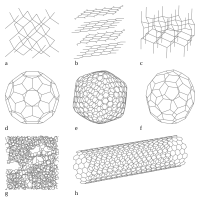
Photo from wikipedia
Antibiotics are among the most critical environmental pollutant drug groups. Adsorption is one of the methods used to eliminate these pollutants. In this study, activated carbon was produced from pumpkin… Click to show full abstract
Antibiotics are among the most critical environmental pollutant drug groups. Adsorption is one of the methods used to eliminate these pollutants. In this study, activated carbon was produced from pumpkin seed shells and subsequently modified with KOH. The adsorbent obtained through this procedure was used to remove ciprofloxacin from aqueous systems. Fourier Transform-Infrared Spectroscopy (FT-IR), Scanning Electron Microscopy (SEM), elemental, X-ray Photoelectron Spectroscopy (XPS), Brunauer–Emmett–Teller (BET) and Zeta analyses were used to characterize the adsorbent. The surface area, in particular, was found to be a very remarkable value of 2730 m2/g. The conditions of the adsorption experiments were optimized based on interaction time, adsorbent amount, pH and temperature. Over 99% success was achieved in removal operations carried out under the most optimal conditions, with an absorption capacity of 884.9 mg·g−1. In addition, the Langmuir isotherm was determined to be the most suitable model for the adsorption interaction.
Journal Title: Molecules
Year Published: 2022
Link to full text (if available)
Share on Social Media: Sign Up to like & get
recommendations!